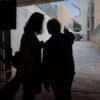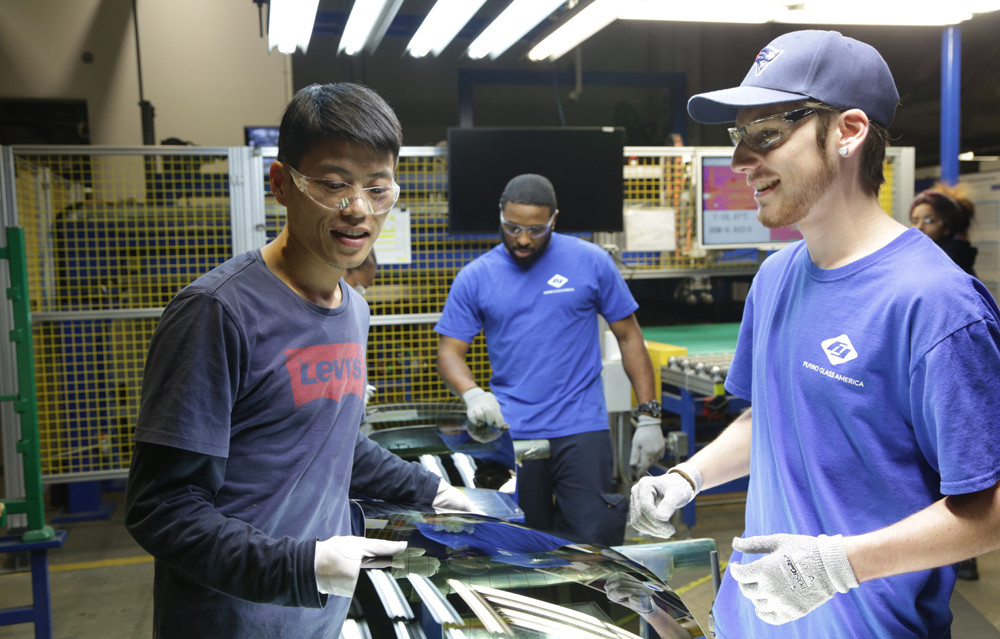There’s a moment in “American Factory” in which there are no words for what you are watching as a business presentation breaks into boisterous, full-on celebration at the Fuyao Glass Factory headquarters in the Fujian Province of China, complete with musical numbers extolling the company’s virtues and principles. When one of the American executives from Fuyao’s newly opened plant in Dayton, Ohio is rendered speechless, you think you know exactly what his mind as tears stream down his face following a show of unabashed corporate devotion that you could never imagine happening back home, but these are not tears of laughter. They are tears of joy.
“We’re one big world,” the exec says, genuinely touched and wiping away his eyes in a moment of jubilation that will no doubt stay with him as he returns West. However, as with much of what Julia Reichert and Steven Bognar capture so remarkably and entertainingly well in “American Factory,” the gulf between what lives in the mind and how things really are between countries in a globalized economy can be as wide a gap as the Atlantic Ocean.
After previously documenting the closure of their local GM plant in “The Last Truck,” the filmmakers began making the 20-minute drive from their home once again in 2015 to talk to workers at the factory under considerably different circumstances. Whereas Bognar and Reichert had once camped outside to catch employees to discuss the impending loss of a steady job in 2007, they were welcomed with open arms to step inside by Fuyao, the new company in town that was set to make a $500 million investment in the community, as they reopen the plant. Hopes are high among employees and executives from both the U.S. and China about the new plant, which will put windows in cars from GM, Chrysler, Toyota and Honda, but there’s also considerable uncertainty about how the two cultures will mesh, particularly when Chinese standards for productivity include workplace practices that are unheard of, or would even be considered illegal, in the States. (“Only eight hours a day, that’s an easy life,” one of the workers brought in from the mainland to work at Dayton can be heard saying, with another marveling later that Americans have time to work two jobs, if they want.)
While a natural comedy emerges from this cultural clash as the filmmakers follow both American and Chinese workers home to see how they adjust to this arrangement, as well as a compelling drama when the plant doesn’t perform up to initial expectations and chatter starts on the factory floor about unionizing, “American Factory” becomes transcendent with how it can bridge the divide in what ways it can, showing how badly everyone on hand wants this to succeed and a common desire for stability and prosperity at a time when that’s difficult to find anywhere in the world. Top brass at Fuyao may bristle at the notion of coffee breaks and the blue collar American workers may find the lofty aspirations of the Chinese who believe in their work with a near-religious fervor to be a bit excessive, but Bognar and Reichert, two of the most sensitive and empathetic filmmakers currently working, locate the ways in which the two cultures can learn from one another and where they should take pride in what differentiates them.
Following a year where these legendary figures within the documentary community have been rightfully acknowledged on a greater scale, with “American Factory” becoming the first release under Barack and Michelle Obama’s production label Higher Ground at Netflix and career retrospectives at MoMA and Full Frame, Bognar and Reichert were recently in Los Angeles to talk about their latest feature, realizing they were telling a story of two cultures instead of taking the perspective of one, and how they created a production pipeline to process all the material they collected from a cross-continental shoot that spanned nearly three years.
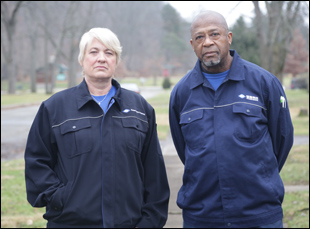
Julia Reichert: Absolutely. Also the fact we were making a short [with “The Last Truck”], we pretty much realized it wasn’t going to be a feature. That story was told from the point of view of the workers that were going to lose their jobs in the end and we didn’t really have access to the white collar people. Nobody from GM would talk with us. We didn’t have any access to meetings or anything like that at all and even if we did, I’m not sure it would’ve been the right way to go. And what was happening to blue collar people all around the country and certainly all around the heartland and in the Midwest where we live was the most significant thing – the huge amount of job loss and communities being devastated, so we could go to people’s homes. At first, we talked to people in their cars as they were leaving work. We’d stand out there day after day with the sign, “Stay strong! Hang in there Lorain Assembly! Thank you for your work.”
Eventually people would start stopping their cars and say a few words with us. Then some of them we met at a local bar or at their house. But really, the focus was on the blue collar workers. And what happened with this film [“American Factory”] was since we had access to everyone , and we couldn’t just follow the blue collar workers. That wasn’t the heart of the story. The bigger story is this rivalry, you could call it, going on between China and the U.S. and the idea that our blue collar town of Dayton, Ohio was going to be changed somehow by this Chinese company coming in. We didn’t know how, but we knew it was going to be interesting and important.
You suggested at True/False that you realized about a year into filming that it was going to be as important to follow the Chinese workers as the Americans. How did that shift in perspective come about?
Julia Reichert: When we first started this, we were aware that the rivalry between China and the U.S. was one of the big stories of the 21st century, and the new president wasn’t there yet. We were still in the run-up to the election. But I remember walking in that [Fuyao] plant the first few times and on the one hand, you’re really struck as a filmmaker by the beauty of it — people are inspecting glass, so they’re bathed in this beautiful, almost movie light, but then pretty quickly, we started noticing that there were several hundred people from mainland China who had never been to the U.S. before — they had pretty much never been anywhere before — and here they land in in Dayton, Ohio and they have to make a life there. Many of them are a year or two from seeing their children, and the more white collar people bought suburban homes [where they] had to learn about cutting the grass and getting their kids in school who did not speak a word of English.
So we at first thought, “Wow, this is impacting them, but also our community because there are several hundred Chinese families, some of them at least getting into the school system and shopping at the grocery store,” and we thought it would have an impact on our community. But what we really realized is that to really get into the lives of blue collar Chinese folks like Wong [He, the lead Furnace Engineer at Fuyao Glass America] and like [Daquin Liang, the lead supervisor], who you see in the film, we couldn’t talk to them. We don’t speak Mandarin Chinese. So we wanted to bring on Chinese field producers and eventually, Chinese co-producers [because] if we’re going to get into the hearts and minds and lives of blue collar Americans, we realized this story really demanded that we get into the hearts and minds and lives of the blue collar Chinese as well, which was a much more difficult task for a lot of reasons, but one big one was language.
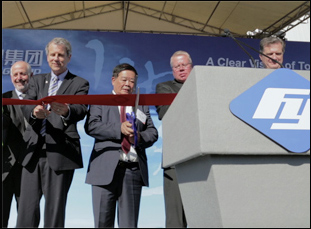
Julia Reichert: It’s a funny story. Before we had those field producers that were Chinese speakers, Jeff Reichert came onboard early on and said, “Look, let me follow some of the Chinese guys. Guys don’t talk that much [in general] anyway, so it probably doesn’t really matter that I can’t talk to them.” [laughs] So he followed them fishing, and you see the fishing scene where the good ol’ American guys are helping the Chinese and interacting and having fun together – he shot that because he just started following the young Chinese guys who are more or less his age and he just started following them wherever they would go.
Steven Bognar: And as documentary filmmakers, we’re always asking ourselves, what are the stakes for everybody? Everyone at some level or another have stakes, so we need to dig into them.
Julia Reichert: Our hearts were with the blue collar Americans, who as you point out, we’d all gotten to know in “The Last Truck,” and we understood the stakes for them, right? The stakes were. “Am I going to have a secure life again? Is this job going to be a good job? Am I going to be treated with respect [at Fuyao]? What’s it going to be like?” But the stakes were going to be different for the Chinese blue collar workers and we really had to focus on that.
What was actually traveling to China when you went to see the Fuyao facilities there?
Steve Bognar: The two weeks in China was so eye-opening. It’s hard to put into words, but the analogy I use is I thought I had eaten Chinese food because I’ve been going to Chinese restaurants here in the U.S. for decades, but when we got to China and sat down and had our first big Chinese meal, it was so rich, nuanced, complex and delicious that it was like it opened up a whole new world for us. And that’s analogous to our cultural experience of being there — the depth of the people, their warmth, the history of the culture — it was just so layered. It’s parallel to our country and our culture here, but it was so new and overwhelming.
Julia Reichert: And pretty much what we were doing in China was we were in Fuyao factories in Fuqing, China, so of course we had handlers at first who walked around with us, but our team is experienced documentarians, so you find ways to break away and talk to people as they’re working or in the cafeteria. Being there helped us so much better understand the cultural collision that was going on and why the Chinese, whether they’re management, blue collar, or people training American workers, were having such a hard time being successful in the U.S. because we saw how their factories work – the efficiency, the speed and the ways in which they learn is very different from the way Americans understand what learning a new job looks like. So all these Chinese folks brought all that over with them and were not really given much guidance about how to negotiate successfully with an American management style and training style.
Steve Bognar: And [that trip] really drove home to us what the Chinese team in America were missing [when they were in the U.S.]. They’re stuck in Dayton, Ohio and they’re missing all this incredibly rich culture and food — the intensity of the community is really strong — and being in China made us have a lot more empathy for what they were missing.
Julia Reichert: Yeah, a lot of them, life in the U.S. was much more boring. There was much less to do. And we didn’t quite get that until we went to their city, which is not very big, and everything’s hopping until the middle of the night. We spent time with Wong’s wife and children and their life was much more difficult. They missed their dad and she missed her husband, but they made the sacrifice easily. There was no big decision because they’re trying to build that company and that’s built into trying to build China, and the workers there that we’ve met, they’re committed not only to building the company, but their country in a way that I don’t think American workers nowadays share. They don’t feel great about their country has treated them. They don’t feel great necessarily about the direction that the working class people of the U.S. are going, but…
Steven Bognar: There’s a real sense of mission in China.
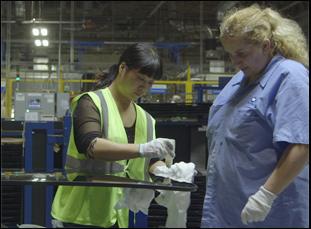
Steven Bognar: Yeah, Lindsay came onboard the summer of 2017. We were still filming very intensively at that point, and Lindsay spent the first six, seven, eight months of working on the film just watching hundreds and hundreds of hours of footage. All told we have 12,000 hours of material and just to get her head around it, she would dive into and immerse herself in the footage day after day all of the stuff we had already shot while we were still recording every day. And this film has five main cinematographers and then additional camera people for big events, so it was a lot of material — the five of us would go into the factory in different areas and film simultaneously because we’re following different people, so the amount of footage that kept coming back to the edit room was voluminous. But Lindsay, Julia and I, and then Jeff Reichert, our producer/cinematographer — filled a huge wall with index cards of story threads and people that we had been following and we just talked it through for almost a solid week. By the end of that week, we had a notion of a first direction in which to go. A beginning of a structure. And then Lindsay started roughing it together.
Julia Reichert: And this is the first time we’ve really hired an editor. Steve is usually the main editor and I’m there critiquing cuts, but I’m really, really glad we chose Lindsay because right from the outset, she said, “Look, guys, I think we should make this film based on scenes that are captured in front of the camera” – in other words, verite scenes, even though we shot many, many hours of sit-down interviews, beautifully lit with all the characters and other characters who aren’t even in the film.
Steven Bognar: And we did have these conversations [about] the films we love like “Harlan County U.S.A.” and some of Steve James’ films [where] the verite scenes are like the beating heart, the engine of drama, so even though we had done all these interviews, when Lindsay started to say the verite material is so strong, let’s build on that, we agreed.
Julia Reichert: She said, “Let’s use those [interviews] as voiceover,” and she always talks about brush strokes, like “All we need is a little brush stroke of that and the audience will get it,” so she really pulled us in that direction.
Steven Bognar: In addition to her being a really brilliant editor, she was just ferociously unstoppable. There was so much work to do and for a year-and-a-half [from] Summer 2017 until the end of 2018, she was relentless.
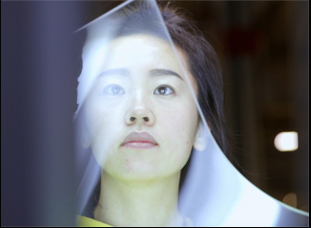
Steven Bognar: It’s wonderful and exciting. We feel very fortunate that the film is having this really strong response. We’ve been making films now for a long time, but we’ve never had a film that has been so in demand, and the conversations we’ve had, whether they’re in San Francisco with a mixed Asian-American audience or in the heartland in Detroit or in Cleveland where we’re talking [with] much more blue collar, former industrial workers, we hope this film will spark intense conversations. We tried to make a film that was even-handed because so many conversations these days are polarized. You immediately run to the barricades and you feel like you can’t talk to anyone. And we’ve tried to craft something with nuance and the conversations that we feel so lucky to be having, they have had depth to them and that’s very meaningful.
Julia Reichert: Yeah, everybody enjoys it, but I think by the end, it’s unsettling. It’s not a film you stand up and cheer about. I was thinking it’s a little like the end of “The Graduate” where you’ve seen all these things happening, but then the very last scene, some kind of new reality sets in and you realize “Wow, there’s even more than I just saw to this whole story.” And we really, really want to be at Q & As as much as we can because I think we’re able to answer some of people’s unsettled questions or at least address them and start conversations.
“American Factory” is now streaming on Netflix. It opens theatrically on August 21st in Los Angeles at the Landmark.
